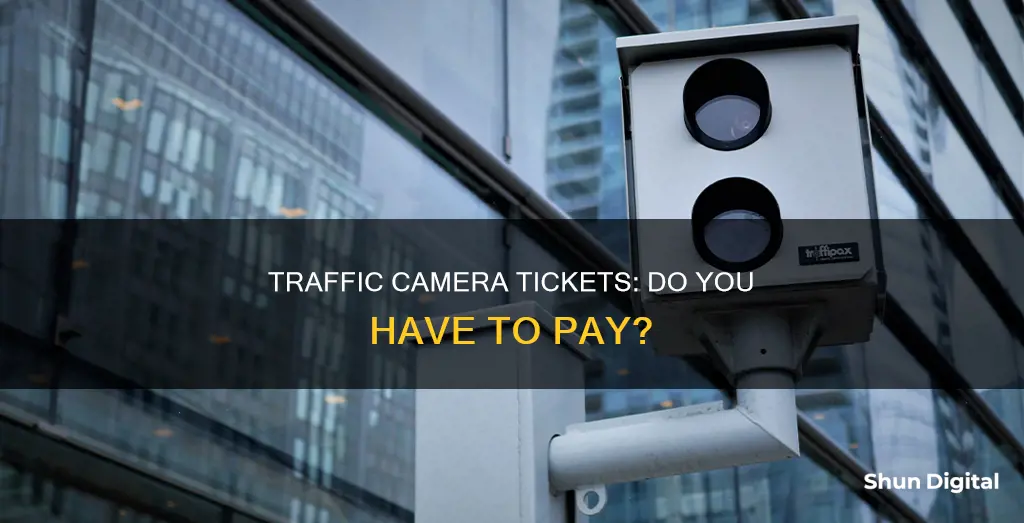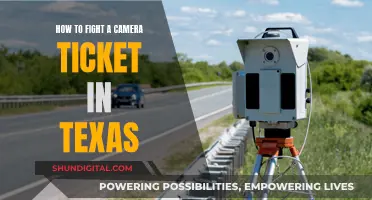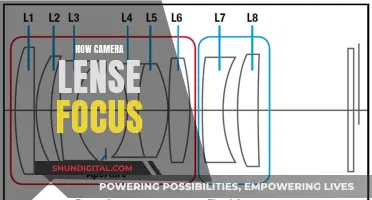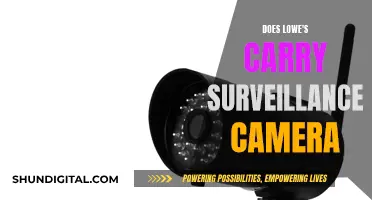
Traffic cameras in East Cleveland have been the subject of much debate, with residents questioning the legality of fines issued by the local police. While some argue that these cameras improve road safety, others claim they are simply a way for the city to generate revenue. In February 2023, the East Cleveland City Council ended the practice of issuing fines based on traffic camera evidence, following a ruling by the Ohio Supreme Court. This decision came after challenges from East Cleveland and Newburgh Heights, who argued for protection under the state's Home Rule statutes.
So, do you have to pay a ticket issued by an East Cleveland traffic camera?
| Characteristics | Values |
|---|---|
| Location | East Cleveland, Ohio |
| Ticket Cost | $95-105 |
| Ticket Issuer | Out-of-town third-party vendor |
| Warning Signs | Not always present |
| Legality | Questioned by residents |
| Council Vote | To end ticketing based on traffic cameras |
| Mayor's Vote | To continue using traffic cameras |
What You'll Learn
- The legality of traffic camera tickets in East Cleveland
- The absence of warning signs before traffic cameras
- The financial implications of traffic-camera fines for municipalities
- The impact of erroneous tickets on driving records and insurance rates
- The role of police officers in the use of traffic cameras

The legality of traffic camera tickets in East Cleveland
In 2017, Sean Mellino received a speeding ticket from the East Cleveland Police Department, which left him confused as he believed that the cameras were illegal. According to an Ohio law that came into effect in 2015, restrictions were added to the use of traffic cameras, requiring an officer to be present alongside the camera. Mellino's speeding ticket did not include the name or badge number of any officer who was present when the photo was taken. Defense attorney Adam VanHo stated that until the Ohio Supreme Court rules on the constitutionality of the law, East Cleveland needs to have those posts manned.
In February 2023, the East Cleveland City Council approved a resolution to end the practice of issuing fines to drivers based on violations captured by traffic cameras. This decision followed a ruling by the Ohio Supreme Court, which unanimously upheld a 2019 state law that set financial disincentives for local governments in Ohio to use cameras for issuing fines for driving infractions. This law reduces state funding to municipalities by the amount of money billed in traffic-camera fines and requires local governments to pay costs and fees in advance when taking civil action to enforce a traffic-camera citation, except in school zones.
Despite the legal debate and challenges, some East Cleveland leaders continue to support the use of traffic cameras as a safety and enforcement tool. They argue that the cameras deter unsafe driving, free up police resources, and provide an opportunity for individuals to fight their citations in court. However, critics claim that the cameras are nothing more than a revenue generator for the city, and in some cases, as evident from Joann Gibson's story, the tickets issued are incorrect and unfair.
As of July 2019, there were also concerns about the lack of warning signs posted near the traffic cameras in East Cleveland, which some argued undermined the safety rationale for their implementation.
While the legality of traffic camera tickets in East Cleveland has been contested, the responsibility for paying any fines ultimately falls on the individual. Those who wish to contest a ticket can choose to do so in court, although this may incur additional costs and require significant time and effort.
Understanding DVR Mode on Your Muddy Camera
You may want to see also

The absence of warning signs before traffic cameras
Warning signs are an essential component of road safety, providing drivers with advance notice of potential hazards or changes in road conditions. These signs are strategically placed to protect drivers, road workers, pedestrians, and other motorists. The absence of warning signs before traffic cameras in East Cleveland has sparked controversy among residents, with some questioning the city's motives and adherence to the law.
In the case of East Cleveland, the lack of warning signs has led to concerns about revenue generation rather than road safety. Residents have expressed frustration over receiving unexpected traffic camera tickets, with some feeling that the absence of warning signs turns the cameras into a "cash grab." This perception is reinforced by the significant number of tickets issued, generating substantial revenue for the city.
The law states that warning signs are not a legal requirement for speed cameras. However, the absence of warning signs can create a sense of unfairness and frustration among drivers. It is important to note that while warning signs are not mandatory, they serve a critical purpose in promoting road safety and reducing accidents.
In the specific case of East Cleveland, the absence of warning signs before traffic cameras may be a result of oversight or a lack of compliance with regulations. It is the responsibility of local jurisdictions to ensure that traffic signs are properly placed, maintained, and replaced if damaged or missing. In this case, the city's Law Director, Willa Hemmons, was not immediately available for comment, and the clerk at City Hall was unaware of the missing sign.
To address this issue, residents can take several actions. First, individuals can follow the example of Chris Jones, who researched the law and advocated for himself after receiving a ticket. Second, residents can contact their local government representatives, as East Cleveland Council President Twon Billings has done, to express their concerns and seek resolution. Finally, drivers can pay close attention to their surroundings and be mindful of speed limits, even in the absence of warning signs, to avoid receiving tickets.
Understanding Camera Raw's Unique Circular Slider
You may want to see also

The financial implications of traffic-camera fines for municipalities
Traffic cameras are often regarded as a cash grab by municipalities, but they are also proven to be one of the most effective ways to get motorists to slow down and save lives. In the case of East Cleveland, the use of traffic cameras has been a contentious issue, with some claiming that the cameras are more about generating revenue than promoting safety.
Some residents of East Cleveland, such as Chris Jones, have taken issue with the lack of warning signs posted near the traffic cameras. Jones, who received a ticket for not fully stopping while making a right turn, argued that the city of East Cleveland should also be held accountable to the law, which states that there should be a warning sign within 300 feet of any photo light. This suggests that the placement of traffic cameras can have an impact on the number of fines issued and, consequently, the amount of revenue generated for the municipality.
Another financial implication of traffic-camera fines for municipalities is the potential for reduced state funding. In the case of Ohio, the state Supreme Court ruled that while cities like East Cleveland have the right to levy taxes and obtain revenue from traffic-camera fines, this does not mean that they are immune to reductions in state funding based on the amount they receive from traffic violations. This "spending setoff" is intended to discourage cities from relying too heavily on traffic-camera fines as a source of revenue.
In addition to the direct financial implications, there are also indirect costs associated with traffic-camera fines. For example, the administrative costs of processing and enforcing the fines can be significant, particularly if there are disputes or challenges to the tickets. In the case of East Cleveland, there have been instances where incorrect tickets have been issued, such as in the case of Joann Gibson, who received a speeding ticket even though her van was being towed. Such incidents can lead to increased costs for the municipality, as well as negative publicity and public sentiment.
Overall, the financial implications of traffic-camera fines for municipalities can be complex and multifaceted. While the fines can provide a source of revenue for local governments, there are also potential costs and consequences that must be considered. It is important for municipalities to balance the financial benefits of traffic-camera fines with the need to promote safety and fairness for residents.
Understanding Camera Raw: Unlocking Photography's Full Potential
You may want to see also

The impact of erroneous tickets on driving records and insurance rates
Traffic violations can have a significant impact on your driving record and insurance rates. In the case of East Cleveland, there have been instances where individuals have received tickets from traffic cameras even when they were not driving, such as Joann Gibson, who received a speeding ticket when her van was being towed. Situations like these can result in erroneous tickets that can have unfair consequences.
Erroneous tickets, such as the one issued to Joann Gibson, can have a detrimental effect on driving records and insurance rates. A single speeding ticket can stay on your driving record for up to five years, and during this time, your insurance rates may be impacted. While a clean driving record may not be significantly affected by one minor speeding ticket, multiple tickets within a short period can result in higher insurance rates. For example, receiving two or more speeding tickets within three years will likely lead to increased insurance rates.
The impact of erroneous tickets on insurance rates can be substantial. According to data from The Zebra, an insurance comparison site, traffic violations can cause insurance rates to soar by up to 82%. More serious offenses, such as hit-and-run violations or refusing a breathalyzer test, can result in rate increases of over 74% to 82%. Even minor violations, such as not wearing a seatbelt or driving without headlights, can lead to average rate hikes of 3.4% to 4.0%.
In addition to the financial consequences, erroneous tickets can also affect your driving record and reputation as a driver. Multiple tickets can result in demerit points on your driver's license, which can lead to your license being suspended or revoked. For example, in Arizona, accumulating eight or more points in 12 months can result in a suspension of your license for up to a year.
To avoid the impact of erroneous tickets, it is essential to review your tickets carefully and contest them if they are incorrect. In the case of traffic camera tickets, understanding the laws and guidelines regarding their use can help you identify any violations by the issuing authority. For example, in East Cleveland, there is a requirement to have a warning sign posted within 300 feet of a photo light, and the presence of a police officer at the red-light camera. If these requirements are not met, the ticket may be invalid.
Wired Lorex Cameras: How Long Do They Last?
You may want to see also

The role of police officers in the use of traffic cameras
Traffic cameras, also known as red light cameras, speed cameras, or road safety cameras, are an increasingly common tool used by police officers to enforce traffic laws and improve road safety. These cameras are typically mounted on roadsides, traffic signals, or enforcement vehicles and are used to detect and deter various motoring offences, including speeding, running red lights, and unauthorized use of bus lanes. While the use of traffic cameras has sparked debates around privacy and government surveillance, they have been shown to effectively reduce accidents, injuries, and traffic violations.
Police officers play a crucial role in the operation and implementation of traffic cameras. They are responsible for monitoring the camera footage, reviewing violations, and issuing tickets or fines to offending drivers. In some cases, officers may be dispatched to pull over a vehicle observed violating traffic laws through the camera system. This direct enforcement capability allows police to take immediate action against dangerous driving and can act as a deterrent.
Additionally, police officers are often involved in the strategic placement of traffic cameras. By analyzing accident data, traffic flow patterns, and areas with high rates of violations, officers can identify locations where cameras would have the most significant impact on road safety. This proactive approach allows for efficient utilization of resources and maximizes the benefit to the community.
Furthermore, police departments play a critical role in evaluating the effectiveness of traffic cameras. By analyzing data and conducting research, they can determine the impact of camera systems on reducing accidents, injuries, and fatalities. This evaluation process ensures that traffic cameras are achieving their primary goal of enhancing road safety and justifies their continued use and expansion.
While traffic cameras provide an additional tool for law enforcement, they do not replace the role of police officers in ensuring road safety. Traditional traffic policing methods, such as patrols and speed traps, remain essential in deterring and responding to traffic violations. The combination of traffic cameras and proactive police presence can create a comprehensive approach to road safety, improving driver behaviour and reducing the risk of accidents.
In conclusion, traffic cameras serve as a valuable tool for police officers in their efforts to enforce traffic laws and enhance road safety. Through strategic placement, monitoring, and enforcement, police departments can utilize these cameras to deter and reduce traffic violations, ultimately making roads safer for drivers and pedestrians alike.
Alabama's Camera-Based Speeding Tickets: Are They Legal?
You may want to see also
Frequently asked questions
As of February 2023, East Cleveland no longer issues fines to drivers whose violations were confirmed through traffic cameras. This decision was made after the Ohio Supreme Court upheld a 2019 state law that set financial disincentives for local governments in Ohio to use cameras to fine motorists for driving infractions.
The Ohio Supreme Court unanimously upheld a 2019 state law that set financial disincentives for local governments to use cameras to fine motorists. The law reduces state funding to a municipality by the amount of money it bills in traffic-camera fines.
There have been concerns over the legality of speeding tickets issued by East Cleveland police from unmanned traffic cameras. In 2015, an Ohio law added restrictions on the use of traffic cameras, requiring an officer to be stationed by the camera. However, some people still received tickets without an officer present, leading to confusion and debate.
If you receive a traffic camera ticket, you have a few options. You can pay the fine upfront, as many people choose to do. Alternatively, you can fight the ticket in court, but this may cost more than the amount of the fine. In the case of incorrect tickets, you may need to contact the third-party vendor issuing the tickets or seek legal advice to get the ticket expunged.







